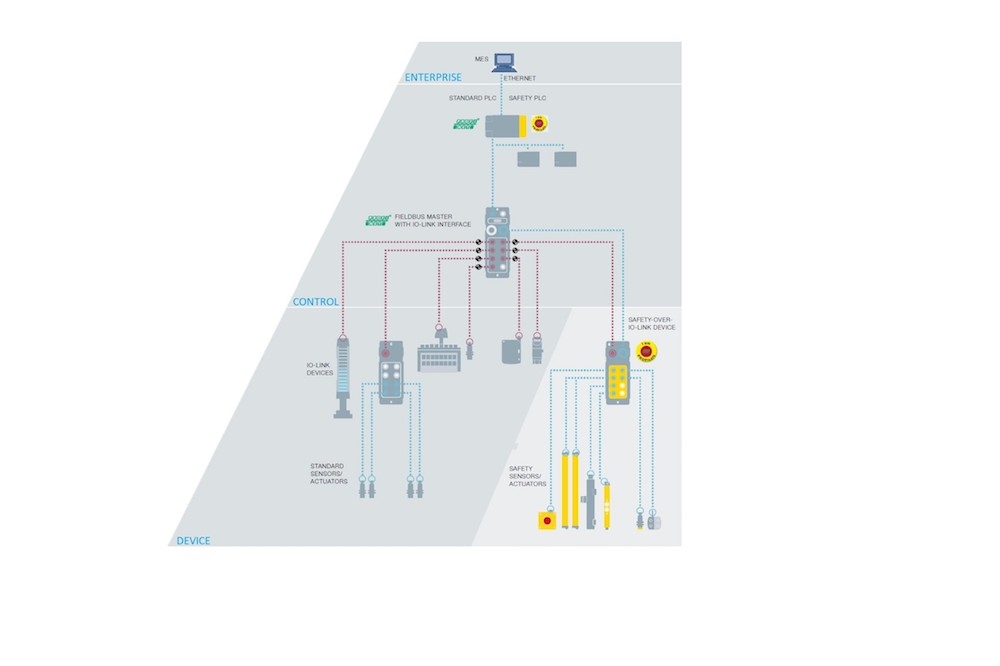
Implementing device-level safety communications
November 14, 2018
By Tom Knauer Balluff Inc.

November 14, 2018 – Manufacturing is rapidly changing, driven by trends such as low volume/high mix, shorter lifecycles, changing labour dynamics and other global factors. One way industry is responding to these trends is by changing the way humans and machines safely work together, enabled by updated standards and new technologies including safety communications.
In the past, safety systems used hard-wired connections, often resulting in long cable runs, large wire bundles, difficult troubleshooting and inflexible designs. The more recent shift to safety networks addresses these issues and allows fast, secure and reliable communications between the various components in a safety control system. Another benefit of these communications systems is that they are key elements in implementing the Industrial Internet of Things (IIoT) and Industry 4.0 solutions.
Within a typical factory, there are three or more communications levels, including an enterprise level (Ethernet), a control level (Ethernet-based industrial protocol) and a device/sensor level (various technologies). The popularity of control- and device-level industrial communications for standard control systems has led to strong demand for similar safety communications solutions.
Safety architectures based on the most popular control-level protocols are now common and often reside on the same physical media, thereby simplifying wiring and control schemes. These Ethernet-based safety protocols are high speed, can carry fairly large amounts of information and are excellent for exchanging data between higher-level devices such as safety PLCs, drives, CNCs, HMIs, motion controllers, remote safety I/O and advanced safety devices. Ethernet is familiar to most customers, and these protocols are open and supported by many vendors and device suppliers – customers can create systems using products from multiple suppliers. One drawback, however, is that devices compatible with one protocol are not compatible with other protocols, requiring vendors to offer multiple communication connection options for their devices. Other drawbacks include the high cost to connect, the need to use one IP address per connected device and the strong influence by a single supplier over some protocols.
Device-level safety protocols are fairly new and less common, and realize many of the same benefits as the Ethernet-based safety protocols while addressing some of the drawbacks. As with Ethernet protocols, a wide variety of safety devices can be connected (often from a range of suppliers), wiring and troubleshooting are simplified, and more data can be gathered than with hard wiring. The disadvantages are that they are usually slower, carry much less data and cover shorter distances than Ethernet protocols. On the other hand, device connections are physically smaller, much less expensive and do not use up IP addresses, allowing the integration into small, low-cost devices including E-stops, safety switches, inductive safety sensors and simple safety light curtains.
The awareness of, and the need for, device-level safety communications will increase with the desire to more tightly integrate safety and standard sensors into control systems. This will be driven by the need to:
• Reduce and simplify wiring
• Add flexibility to scale up, down or change solutions
• Improve troubleshooting
• Mix “best-in-class” components from a variety of suppliers to optimize solutions
• Gather and distribute IIoT data to higher-level systems
Many users are realizing that neither an Ethernet-based safety protocol nor a device-level safety protocol can meet all their needs, especially if they are trying to implement a cost-effective, comprehensive safety solution that can also support the IIoT. This is where a safety communications master (or bridge) comes in to assist – it can connect a device-level safety protocol to a control-level safety protocol, allowing low-cost sensor connection and data gathering at the device level, and transmission of this data to the higher-level communications and control system.
Combining device-level and control-level protocols helps users optimize their safety communications solutions, balancing cost, data and speed requirements, and allows IIoT data to be gathered and distributed upwards to control and MES systems.
Tom Knauer is the Safety Business Champion for Balluff, Inc., a sensor manufacturer and supplier of automation system solutions.
This article originally appeared in the November/December 2018 issue of Manufacturing AUTOMATION.
Advertisement
- J.M. Lahman Manufacturing Inc. fined $150K after child killed at factory
- Festo debuts suite of new products at Rockwell Automation event